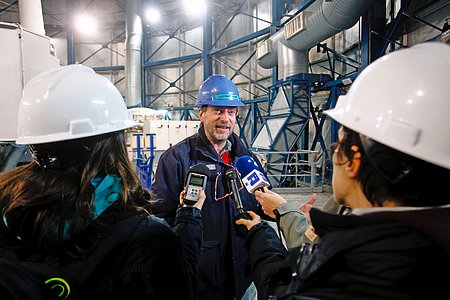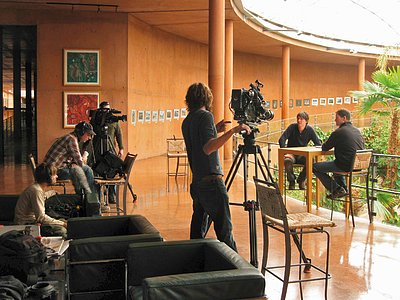Media Visits
Guidelines for media visits to ESO observatories
ESO welcomes media representatives who are interested in visiting its observatories in Chile as part of the production of news stories, documentaries, and other science communication projects. As these visits represent a significant investment of resources on the part of ESO, the ESO Department of Communication reserves the right to choose projects that have the largest return-on-investment, according the Organisation’s values and strategic objectives.
Please note that, requests with any kind of commercial component (i.e. advertisement) are outside the scope of the media visits and will not be considered.
In addition to the standard media visits advertised on this page, which are organised on a per-request basis and are tailored to the needs of individual media visitors, ESO also organises strategic media visits. These visits are guided group visits of accredited journalists in ESO member and partner states to ESO sites that aim at strengthening the visibility of ESO in high-profile media outlets. They take place on specific, fixed dates and travel costs are partly covered by ESO. For more information about strategic media visits and how to apply to join one, please check the Strategic Media Visits and Media Funding Scheme page.
How to apply for a media visit
If you are interested in applying for a media visit, please contact the Department of Communication as far in advance as possible (preferably at least 3 months before your planned visit) by filling in this form. Please note that the processing and evaluation of your request will only be initiated once we receive the form. If you have questions, please contact ESO at contacto@eso.org.
Once you have submitted the form, you should be notified within 48 hours; if not, please send an email.
Your request will be evaluated by the ESO Department of Communication based on the following criteria:
- The amount and type of exposure that ESO will receive.
- In quantitative terms, this is evaluated based on the estimated audience, how much ESO will be featured, and the geographical area of reach (with preference given to audiences in ESO’s Member States and partners Australia and Chile).
- In terms of contents, priority will be given to proposals aligned with ESO’s Communication strategy. In this sense, we aim to raise awareness of challenges and achievements in research, technology development, engineering, management of large and complex projects, highlighting the people who make all this possible.
- On the logistics side, the complexity of the visit and its potential impact on the observatories’ operations, as well as the amount of time available for planning the visit, will be evaluated. Please consider that ESO’s observatories are remote sites devoted to non-stop operations (see “Safety constraints” below). Accommodation on site is limited and its availability is subject to operational needs. Therefore, it is advisable to plan your visit as much in advance as possible, reducing the number of people and nights requested at the site to the minimum needed to fulfil your requirements. Weekdays are preferred.
You will be notified of the result of the evaluation of your proposal within 2 weeks. If the evaluation is positive, ESO will propose a travel itinerary to you.
Once the itinerary is agreed with you, ESO will start the internal arrangements, to reconfirm the accommodation availability on site. You are recommended to not confirm any travel reservations until we notify you the final confirmation from the observatories.
If you have a deadline, please state it clearly in the form.
Cancellation policy
ESO can cancel a visit at any time for force majeure reasons. These include adverse meteorological conditions, natural disasters, health emergencies, operational constraints or any other situation that may impair the safety of the visitors. ESO will immediately notify visitors by all the available means.
Any cancellation by the visitor should be communicated to the Department of Communication at least 48 working hours before the beginning of the visit.
Travel, accommodation & transportation
For any approved media visit, ESO usually grants 2 days / 1 night at ESO’s La Silla and Paranal Observatories. Requests for longer periods are preliminarily evaluated by ESO Department of Communication and are subject to accommodation availability at the observatories. For accredited media representatives, ESO covers:
- Board and lodging at the La Silla Hotel or Paranal Residence.
- Support with the organisation of the visit, including interview arrangements and on-site professional support during the entire visit.
ESO doesn’t cover:
- Accommodation at ALMA Observatory; a list of hotels in San Pedro de Atacama (~40 minutes away from the ALMA base camp) can be found at: http://www.sanpedroatacama.com/.
- Transportation to/from the observatories. Visitors should have a suitable vehicle to reach and leave the observatories, as well as to move around once there.
- Fuel. Please make sure to refill your tank at the closest petrol station before arriving the observatory. Only in case of emergency, will ESO provide an amount of fuel to reach the closest petrol station.
For detailed travel information, please see the Contact and Travel pages.
Safety constraints
- ESO’s observatories are in continuous operation 365 days a year and 24 hours a day. ESO’s priority is to ensure the undisturbed and continued operation of the observatory during the visits.
- Scientific observing has absolute priority over photography and filming. Telescopes cannot be moved or directed to accommodate photography.
- A member of the Department of Communication will be on site to accompany media visitor(s), acting as liaison between the visitors and the personnel on site, and arranging access to telescopes and other facilities. Visitors must follow his/her instructions at any time when on site.
- Any additional support (e.g. use of equipment or facilities) must be authorised in advance by ESO and stated in a formal agreement, which must be signed by both parties. This agreement may include the reimbursement of expenses generated by the use of additional equipment or facilities by the visitor.
- Due to safety and legal restrictions, the reference working time slot for media visits to the observatories is from 08:30 to 00:30. Under exceptional circumstances and when requested in advance, additional night-time can be granted, always guaranteeing a minimum rest period of 8 hours/day.
- No outdoor lights are allowed for exterior shots after sunset at La Silla and Paranal.
- More information about travelling to La Silla is available here; more information about travelling to Paranal is available here.
- The high-altitude site of ALMA (Chajnantor, 5000 metres) has some additional safety constraints. More information is available here.
- For safety reasons, people with pacemakers are not allowed inside the telescopes. This is because the electromagnetic fields generated by the instrumentation may interfere with the device.
- Airplanes, helicopters, drones etc. are under normal circumstances not allowed to fly over/at the observatory. An exceptional authorisation must be requested.
Media release form
Once a media visit has been authorised and confirmed by the Department of Communication, the requester should fill in a media release form, which is available in .doc and .pdf formats. Please submit a signed version to contacto@eso.org before the actual date of the visit.
Main filming locations
- The VLT Unit Telescopes (UTs) (interior and exterior): the interior of telescopes is accessible most of the time during the day, subject to previous authorisation by the telescope manager. However, they cannot be opened. The opening process starts around 45 minutes before sunset. After sunset, access to the telescopes is prohibited, until next sunrise.
- The control room, where operators and astronomers control the telescopes by night. Interviews and interaction with the staff are possible, compatibly with their duties during the night.
- Access to the interferometric delay lines of the VLT Interferometer is restricted. If there is a particular interest and justification for filming this facility, the request should be sent in advance.
- The Residencia.
- ESO's Extremely Large Telescope (ELT): Cerro Armazones, where the construction of ELT is advancing, is 23 km from Cerro Paranal. The site is divided into two main areas: the Armazones Base Camp (ABC), where the offices of the ESO engineers and technicians are located, and the Armazones Top Platform (ATP), where the construction works are taking place. Both areas can be visited during the day under the guidance of ESO personnel, proper personal protection equipment and signing a waiver form. In very exceptional cases, night visits can be accommodated.
- The Operations Support Facility (OSF), at an altitude of 2,900 m.a.s.l. Access to the control room and laboratories is possible but should be requested in advance. Interviews and interaction with the staff are possible, compatibly with their duties.
- The ALMA Array Operation Site (AOS), with the AOS technical building, which houses the ALMA correlator.
- Cerro Chico, and/or other suitable elevated spots adjacent to Chajnantor plateau, for general views of the fascinating altiplano landscape, if conditions allow.
- The ALMA site museum, on the way to AOS.
- The ESO 3.6-metre telescope.
- The New Technology Telescope
- Many host and robotic telescopes.
If you don't see the form above please follow this link.

